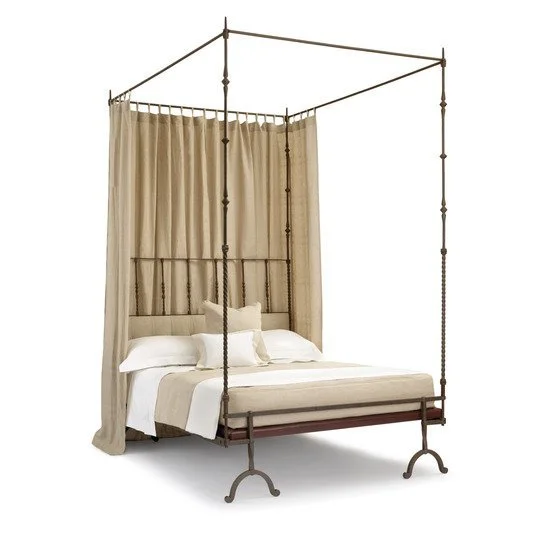Pillow Talk: René Gregorius and the Renaissance Bed
Architectural Digest, Interior Design: Melvin Dwok, Photo: Mary E. Nichols, Bed: Gregorius/Pineo, November 1999
René Gregorius and Stephanie Pineo, aficionados of early antique furnishings, craftsmanship, and design, opened their Los Angeles business Gregorius/Pineo in 1984 at the back of a North La Cienega Blvd storefront. They later moved to an elegant showroom at 651-653 North La Cienega Blvd. Interior Design Hall of Fame honoree Melvin Dwork told Architectural Digest almost ten years later, "Gregorius/Pineo is one of the best places out there." AD wrote that Dwork purchased a wrought-iron four-poster bed based on a Renaissance design from the to-the-trade showroom that specialized in high-end artisanal reproduction furniture. Their line at the time also included a Tuscan-style cabinet, a dining table made with a burl elm, a Louis XV-style cane-back chair, and a Louis XIII Os de Mouton Bergere copied and scaled up from the original that René owned.
René Gregorius enjoying his Los Angeles patio, 2020, seated in a Gregorius/Pineo Twig Iron Arm Chair
When clients visited the showroom, René enjoyed telling them that the wrought-iron four-poster could sleep five. He owned the original, which he discovered while living in San Francisco during the early 1970s. The Amsterdam native moved to the Bay Area in the sixties to direct catering at The Mark Hopkins Hotel, going on to head catering operations at the San Francisco Hilton. But his passion was very early antiques, and when visiting a shop on North Point Street, the dealer named Alfred Koch said, "Take a look at this pile of rusted Renaissance iron. It's a bed, and it's very you."
The pile of rusted iron was at the back of the shop, lying on the ground. René loaded it all into his VW Beetle with the pieces sticking out of the sunroof. He drove home to his 1920s apartment on Bay Street, where after figuring out how to assemble the bed, he removed the rust and waxed it to bring out its beautiful patina. Once installed in the main bedroom, René draped the walls in natural burlap at the suggestion of his friend, the legendary interior designer Michael Taylor. Later, he found a book on early Italian ironwork with a similar bed from the 17th century. The description said, "sleeps five," alluding to communal sleeping, the norm until the Victorians.
Gregorius | Pineo 17th Century Italian Iron Bed
René and Stephanie adjusted the bed's design and included it in the Gregorius/Pineo line. It evolved from no finials per the original to "with finials," which could come with two or four posts and with or without drapery. Of course, they offered sizes Single, Double, Queen, King, or custom to sleep five. Over the years, Gregorius/Pineo's business expanded to serve the top echelons of the design world, with representation in design center showrooms across the nation and an international clientele. In 2004, René and Stephanie sold the business to Kneedler Fauchère, Gregorius/Pineo's first and longest-representing showroom.
Rebranded Gregorius | Pineo, the classical reproduction line of 185 styles morphed into a product house of over 1,000 items with collections ranging from primitive cultures through the 17th, 18th, and 19th centuries and into the modernist periods of the 20th century. Designers still order the Renaissance-styled wrought-iron four-poster bed, now known as the 17th Century Italian Iron Bed. Sadly René passed away in 2022 at his beloved home in Los Angeles. He was 91. Despite his multisyllabic surname being synonymous with exquisite furniture, he was humble and unassuming. "No hoopla, please," he said.
Special thanks to Stephanie Pineo and Stephen Baker, René's partner and husband, for their input.




